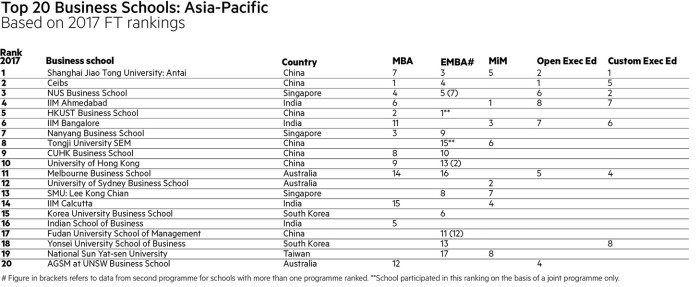FT 2017 top 20 business schools in the Americas and Asia-Pacific

Simply sign up to the Business education myFT Digest -- delivered directly to your inbox.
These new top-20 rankings for the Americas and Asia-Pacific are based on the quality and breadth of business schools’ postgraduate programmes. The Financial Times measured their performance in the main rankings published in 2017: MBA, Executive MBA, Masters in Management (MiM) and the two rankings for Executive Education. The new tables use the same methodology as those for Europe; the exception is that the placings for the Americas do not include the MiM as too few schools participate.

The Wharton School is top in the Americas, ahead of Columbia Business School and MIT Sloan School of Management. Wharton, at the University of Pennsylvania, does not top any individual ranking but performs strongly in all of them. It is second for MBA and seventh for EMBA. Sloan entered the EMBA ranking for the first time, helping the school to third place in the Americas table.
Harvard Business School and Stanford Graduate School of Business are at seventh and 10th respectively. Stanford has the top MBA while Harvard is ranked first and second for open-enrolment and custom executive education programmes, but both lose points for not having an EMBA.
US schools account for the entire top 10 and 15 of the top 20 places. Schools in the east dominate the table. Stanford and the Anderson School of Management at UCLA are the only representatives from the west coast.
Columbia in Upper Manhattan is 10 places above Stern School of Business in Lower Manhattan. Columbia is ahead in all four rankings and is at second and third for its joint EMBA programmes with London Business School, one of which also includes the University of Hong Kong.
Meanwhile, in Chicago, Booth School of Business is fourth, five places ahead of Kellogg School of Management, in nearby Evanston. Kellogg is top of the EMBA ranking thanks to its joint degree with HKUST Business School in Hong Kong. The school is also notable for having three other graded EMBAs (including two joint degrees). However, it is not ranked for executive education.
Incae Business School in Costa Rica is the top non-US school, at 11th. The school features in all four rankings. Its best position is 10th for customised executive education. It is one of two schools in Spanish-speaking countries: Ipade Business School in Mexico is 19th.
The table includes three schools from Canada. Rotman School of Management is 13th, just ahead of Ivey School of Business at 14th and Smith School of Business at Queen’s University at 18th. All three Canadian schools feature in the four individual rankings.

Antai College of Economics and Management at Shanghai Jiao Tong University tops this inaugural ranking of schools in the Asia-Pacific region.
It comes ahead of its local rival Ceibs and the National University of Singapore Business School.
Antai is the only Asian school that features in all five FT rankings. Its best performance is in executive education, where Antai is first and second respectively for customised and open-enrolment programmes. Its executive MBA is ranked third.
Ceibs, the international business school also in Shanghai, is top for both MBA and open-enrolment executive education. It has a better average score but misses out on the top spot overall as it loses points for not having an MiM programme. Shanghai is also home to Tongji and Fudan universities, the two other schools from mainland China in this grading, and so the city completes a clean sweep over Beijing.
Beijing’s Guanghua School of Management appears in the two executive education rankings but falls outside the top 20 here. Nor does the city’s Tsinghua University qualify: it is in the EMBA table only for its joint degree with Insead. Guanghua and Tsinghua are in the FT Masters in Finance ranking, which is not part of this composite ranking. Renmin University did not take part in the FT rankings in 2017.
Singapore is one of the region’s main hubs for business education. Besides its ranked schools, many international rivals such as Insead or Booth have local campuses. NUS Business School is the top local school at third, ahead of Nanyang Business School, at seventh, and Lee Kong Chian at 13th.
Hong Kong is another international hub. Three of its schools make this table, including HKUST Business School. The school, fifth overall, is top for EMBA with its joint programme with Kellogg, and second for MBA.
Indian schools cater almost exclusively for their national market. Almost all faculty and students are Indian. India has four schools in this ranking, the highest of which is the Indian Institute of Management at Ahmedabad, at fourth.
Three Australian schools are in the second half. Melbourne Business School is highest, at 11th, having featured in four out of the five rankings. The University of Sydney Business School, the Cems alliance member for Australia, is 12th overall. It is ranked only for its MiM programme, which is the second best in the region.
Comments